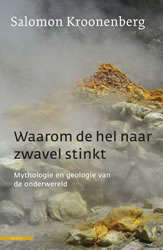Salomon Kroonenberg
Why Hell Stinks of Sulphur (Waarom de hel naar zwavel stinkt)
Mythology and geology of the underworld
We know almost everything about the exterior of the earth, but for most people its interior is completely unknown. Beneath us, stretching for a distance comparable to that between Paris and New York, lies an underground realm associated with darkness and death. It has inspired writers and artists since time immemorial; when trying to imagine hell, they have usually located it under the ground.
Subterranean mythology is geologist Salomon Kroonenberg’s point of departure. With Dante’s Inferno to hand, he takes the reader on a journey in the footsteps of Homer, Virgil, Da Vinci, Descartes and Jules Verne. Along the way he turns a scientific spotlight on the background to myths of the underworld. At a small lake near Naples he searches for the gates of hell, as described in Virgil’s Aeneid. Kroonenberg’s vast reserves of knowledge and his expressive prose allow him to transform even inconspicuous features of the landscape into fascinating sites.
Kroonenberg has the gift of being able to explain complicated matters. He compares the inside of the earth to a gobstopper, ready to expose one gorgeous colour after another. Gasses, ores, liquids and metals add to its immense variety, and there are underground rivers and lakes that have never seen the light of day. The mineworkers of the past, who were often terrified by the strange noises, the darkness, the sudden gushing of water, had their own patron saint, St. Barbara. Even today she is asked to bless tunnelling projects before the drill sets to work.
Kroonenberg is not, however, concerned only with myths, or with the beauty of natural phenomena. He sees the earth beneath our feet as a source of information about the unimaginably ancient planet on which we humans live out our brief lives. We have never penetrated beyond a depth of twelve kilometres, but if this book makes one thing clear, then it is that we should not see the world as a supermarket for raw materials, or simply as rock to be tunnelled through, but as a unique archive, a living ecosystem whose riches we can still barely guess at.
- A fascinating search for the geological foundations of hell.
- An appeal to find ways to ensure a good life for mankind that will not exhaust the earth.
- Kroonenberg keeps up the suspense on all levels, so that his book reads like a voyage of discovery.
Publisher
Atlas
Herengracht 481
NL - 1017 BT Amsterdam
TEL. +31 20 524 98 00
FAX +31 20 627 68 51
E-mail: atlas@uitgeverijatlas.nl
Website: www.uitgeverijatlas.nl
Publishing details
Waarom de hel naar zwavel stinkt. Mythologie en geologie van de onderwereld (2011, 400 pp, 76,000 words)
With colour and black-and-white illustrations, and references
7,800 copies sold

Biography
Salomon Kroonenberg studied physical geography at the University of Amsterdam and completed his doctorate there in 1976. Between 1972 and 1982 he worked as a geologist in Surinam, Swaziland and Columbia before becoming Professor of Geology and Mineralogy at the Agricultural University of Wageningen. In 1996 he left Wageningen to become Professor of Applied Geology at the Technical University of Delft. Until recently Kroonenberg was a columnist for Intermediair. A collection of his columns was published as Stop the Continents! (1996). He is the author of The Human Scale (2006), which won him the Eureka Prize and has been translated into German, Chinese and Turkish.
Website: www.salomonkroonenberg.nl/
Sample translation
Quotes
“An erudite combination of personal and literary travel writing, advocacy of depth-ecology and globe-consciousness, and geological popular science. A terrific, beautifully illustrated book.”
― NRC Handelsblad
“An entertaining book… Delightfully enthusiastic.”
― Vrij Nederland
Category
Genre: non-fiction
Translations
Rights sold
- Reaktion Books (London, )
- Primus (Darmstadt, Duitsland)
- Shanghai Literature and Arts Publishing House (Shanghai, )
- Continued...
